PF-2545920_COA_12098_MedChemExpress
HSF1A_DataSheet_MedChemExpress
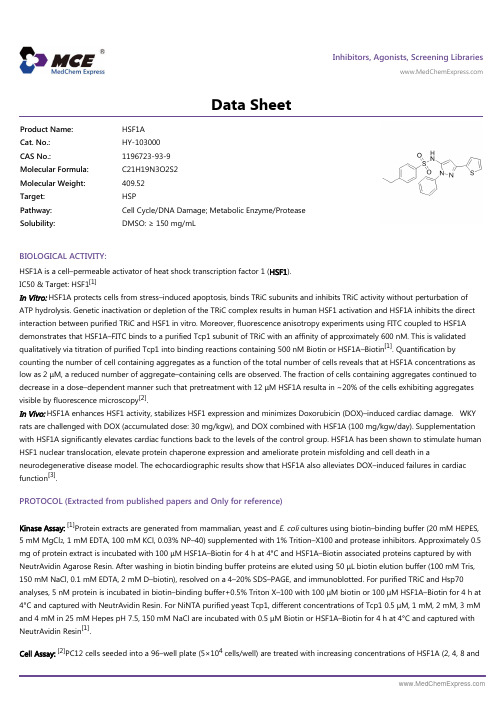
Inhibitors, Agonists, Screening Libraries Data SheetBIOLOGICAL ACTIVITY:HSF1A is a cell–permeable activator of heat shock transcription factor 1 (HSF1).IC50 & Target: HSF1[1]In Vitro: HSF1A protects cells from stress–induced apoptosis, binds TRiC subunits and inhibits TRiC activity without perturbation of ATP hydrolysis. Genetic inactivation or depletion of the TRiC complex results in human HSF1 activation and HSF1A inhibits the direct interaction between purified TRiC and HSF1 in vitro. Moreover, fluorescence anisotropy experiments using FITC coupled to HSF1A demonstrates that HSF1A–FITC binds to a purified Tcp1 subunit of TRiC with an affinity of approximately 600 nM. This is validated qualitatively via titration of purified Tcp1 into binding reactions containing 500 nM Biotin or HSF1A–Biotin [1]. Quantification bycounting the number of cell containing aggregates as a function of the total number of cells reveals that at HSF1A concentrations as low as 2 μM, a reduced number of aggregate–containing cells are observed. The fraction of cells containing aggregates continued to decrease in a dose–dependent manner such that pretreatment with 12 μM HSF1A resulta in ~20% of the cells exhibiting aggregates visible by fluorescence microscopy [2].In Vivo: HSF1A enhances HSF1 activity, stabilizes HSF1 expression and minimizes Doxorubicin (DOX)–induced cardiac damage. WKY rats are challenged with DOX (accumulated dose: 30 mg/kgw), and DOX combined with HSF1A (100 mg/kgw/day). Supplementation with HSF1A significantly elevates cardiac functions back to the levels of the control group. HSF1A has been shown to stimulate human HSF1 nuclear translocation, elevate protein chaperone expression and ameliorate protein misfolding and cell death in aneurodegenerative disease model. The echocardiographic results show that HSF1A also alleviates DOX–induced failures in cardiac function [3].PROTOCOL (Extracted from published papers and Only for reference)Kinase Assay:[1]Protein extracts are generated from mammalian, yeast and E. coli cultures using biotin–binding buffer (20 mM HEPES,5 mM MgCl 2, 1 mM EDTA, 100 mM KCl, 0.03% NP–40) supplemented with 1% Trition–X100 and protease inhibitors. Approximately 0.5mg of protein extract is incubated with 100 μM HSF1A–Biotin for 4 h at 4°C and HSF1A–Biotin associated proteins captured by with NeutrAvidin Agarose Resin. After washing in biotin binding buffer proteins are eluted using 50 μL biotin elution buffer (100 mM Tris,150 mM NaCl, 0.1 mM EDTA, 2 mM D–biotin), resolved on a 4–20% SDS–PAGE, and immunoblotted. For purified TRiC and Hsp70analyses, 5 nM protein is incubated in biotin–binding buffer+0.5% Triton X–100 with 100 μM biotin or 100 μM HSF1A–Biotin for 4 h at 4°C and captured with NeutrAvidin Resin. For NiNTA purified yeast Tcp1, different concentrations of Tcp1 0.5 μM, 1 mM, 2 mM, 3 mM and 4 mM in 25 mM Hepes pH 7.5, 150 mM NaCl are incubated with 0.5 μM Biotin or HSF1A–Biotin for 4 h at 4°C and captured with NeutrAvidin Resin [1].Cell Assay:[2]PC12 cells seeded into a 96–well plate (5×104 cells/well) are treated with increasing concentrations of HSF1A (2, 4, 8 andProduct Name:HSF1A Cat. No.:HY-103000CAS No.:1196723-93-9Molecular Formula:C21H19N3O2S2Molecular Weight:409.52Target:HSP Pathway:Cell Cycle/DNA Damage; Metabolic Enzyme/Protease Solubility:DMSO: ≥ 150 mg/mL12 μM) for 15 h, at which time httQ74–GFP expression is stimulated by incubation in the presence of 1 μg/mL Doxycycline for 5 d. Cell viability is assessed via the XTT viability assay[2].Animal Administration:[3]Rat[3]Ten–week–old Wistar Kyoto rats (WKY) are used. The rats are housed at a constant temperature (22°C) on a 12–h light/dark cycle with food and tap water. The animals are arranged into three groups: WKY rats (the control group), DOX rats and DOX rats treated with HSF1A. Each group contain five animals. The DOX group is injected with DOX (5 mg/kg) for 6 consecutive weeks intraperitoneal injection to achieve a cumulative dose of 30 mg/kg, which has been well documented to achieve cardiotoxicity. The small molecular HSF1 activator HSF1A (100 mg/kg/day) is injected intraperitoneally.References:[1]. Neef DW, et al. A direct regulatory interaction between chaperonin TRiC and stress–responsive transcription factor HSF1. Cell Rep. 2014 Nov 6;9(3):955–66.[2]. Neef DW, et al. Modulation of heat shock transcription factor 1 as a therapeutic target for small molecule intervention in neurodegenerative disease. PLoS Biol. 2010 Jan 19;8(1):e1000291.[3]. Huang CY, et al. Doxorubicin attenuates CHIP–guarded HSF1 nuclear translocation and protein stability to trigger IGF–IIR–dependent cardiomyocyte death. Cell Death Dis. 2016 Nov 3;7(11):e2455.Caution: Product has not been fully validated for medical applications. For research use only.Tel: 609-228-6898 Fax: 609-228-5909 E-mail: tech@Address: 1 Deer Park Dr, Suite Q, Monmouth Junction, NJ 08852, USA。
超高效液相色谱-串联质谱法测定人血浆中精氨酸及衍生物含量
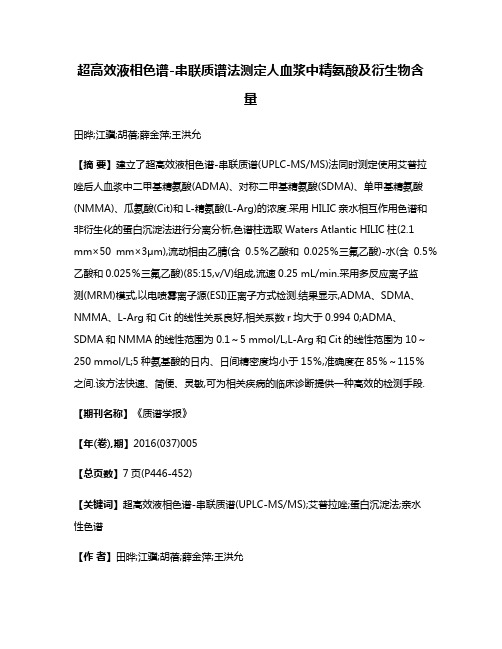
超高效液相色谱-串联质谱法测定人血浆中精氨酸及衍生物含量田晔;江骥;胡蓓;薛金萍;王洪允【摘要】建立了超高效液相色谱-串联质谱(UPLC-MS/MS)法同时测定使用艾普拉唑后人血浆中二甲基精氨酸(ADMA)、对称二甲基精氨酸(SDMA)、单甲基精氨酸(NMMA)、瓜氨酸(Cit)和L-精氨酸(L-Arg)的浓度.采用HILIC亲水相互作用色谱和非衍生化的蛋白沉淀法进行分离分析,色谱柱选取Waters Atlantic HILIC柱(2.1 mm×50 mm×3μm),流动相由乙腈(含0.5%乙酸和0.025%三氟乙酸)-水(含0.5%乙酸和0.025%三氟乙酸)(85:15,v/V)组成,流速0.25 mL/min.采用多反应离子监测(MRM)模式,以电喷雾离子源(ESI)正离子方式检测.结果显示,ADMA、SDMA、NMMA、L-Arg和Cit的线性关系良好,相关系数r均大于0.994 0;ADMA、SDMA和NMMA的线性范围为0.1~5 mmol/L,L-Arg和Cit的线性范围为10~250 mmol/L;5种氨基酸的日内、日间精密度均小于15%,准确度在85%~115%之间.该方法快速、简便、灵敏,可为相关疾病的临床诊断提供一种高效的检测手段.【期刊名称】《质谱学报》【年(卷),期】2016(037)005【总页数】7页(P446-452)【关键词】超高效液相色谱-串联质谱(UPLC-MS/MS);艾普拉唑;蛋白沉淀法;亲水性色谱【作者】田晔;江骥;胡蓓;薛金萍;王洪允【作者单位】福州大学化学学院,福建省功能材料工程研究中心,福建省光动力治疗药物与诊疗工程技术研究中心,福建福州350108;中国医学科学院北京协和医院临床药理中心,北京100730;中国医学科学院北京协和医院临床药理中心,北京100730;中国医学科学院北京协和医院临床药理中心,北京100730;福州大学化学学院,福建省功能材料工程研究中心,福建省光动力治疗药物与诊疗工程技术研究中心,福建福州350108;中国医学科学院北京协和医院临床药理中心,北京100730【正文语种】中文【中图分类】O657.63一氧化氮是人体重要的信使分子,L-精氨酸(L-Arg)在一氧化氮全酶(NOS)的催化下,产生一氧化氮(NO)和瓜氨酸(Cit)[1-2]。
PF-2545920_SDS_MedChemExpress

Inhibitors, Agonists, Screening LibrariesSafety Data Sheet Revision Date:May-24-2017Print Date:May-24-20171. PRODUCT AND COMPANY IDENTIFICATION1.1 Product identifierProduct name :PF-2545920Catalog No. :HY-50098CAS No. :898562-94-21.2 Relevant identified uses of the substance or mixture and uses advised againstIdentified uses :Laboratory chemicals, manufacture of substances.1.3 Details of the supplier of the safety data sheetCompany:MedChemExpress USATel:609-228-6898Fax:609-228-5909E-mail:sales@1.4 Emergency telephone numberEmergency Phone #:609-228-68982. HAZARDS IDENTIFICATION2.1 Classification of the substance or mixtureNot a hazardous substance or mixture.2.2 GHS Label elements, including precautionary statementsNot a hazardous substance or mixture.2.3 Other hazardsNone.3. COMPOSITION/INFORMATION ON INGREDIENTS3.1 SubstancesSynonyms:PF 2545920; PF2545920Formula:C25H20N4OMolecular Weight:392.45CAS No. :898562-94-24. FIRST AID MEASURES4.1 Description of first aid measuresEye contactRemove any contact lenses, locate eye-wash station, and flush eyes immediately with large amounts of water. Separate eyelids with fingers to ensure adequate flushing. Promptly call a physician.Skin contactRinse skin thoroughly with large amounts of water. Remove contaminated clothing and shoes and call a physician.InhalationImmediately relocate self or casualty to fresh air. If breathing is difficult, give cardiopulmonary resuscitation (CPR). Avoid mouth-to-mouth resuscitation.IngestionWash out mouth with water; Do NOT induce vomiting; call a physician.4.2 Most important symptoms and effects, both acute and delayedThe most important known symptoms and effects are described in the labelling (see section 2.2).4.3 Indication of any immediate medical attention and special treatment neededTreat symptomatically.5. FIRE FIGHTING MEASURES5.1 Extinguishing mediaSuitable extinguishing mediaUse water spray, dry chemical, foam, and carbon dioxide fire extinguisher.5.2 Special hazards arising from the substance or mixtureDuring combustion, may emit irritant fumes.5.3 Advice for firefightersWear self-contained breathing apparatus and protective clothing.6. ACCIDENTAL RELEASE MEASURES6.1 Personal precautions, protective equipment and emergency proceduresUse full personal protective equipment. Avoid breathing vapors, mist, dust or gas. Ensure adequate ventilation. Evacuate personnel to safe areas.Refer to protective measures listed in sections 8.6.2 Environmental precautionsTry to prevent further leakage or spillage. Keep the product away from drains or water courses.6.3 Methods and materials for containment and cleaning upAbsorb solutions with finely-powdered liquid-binding material (diatomite, universal binders); Decontaminate surfaces and equipment by scrubbing with alcohol; Dispose of contaminated material according to Section 13.7. HANDLING AND STORAGE7.1 Precautions for safe handlingAvoid inhalation, contact with eyes and skin. Avoid dust and aerosol formation. Use only in areas with appropriate exhaust ventilation.7.2 Conditions for safe storage, including any incompatibilitiesKeep container tightly sealed in cool, well-ventilated area. Keep away from direct sunlight and sources of ignition.Recommended storage temperature:Powder-20°C 3 years4°C 2 yearsIn solvent-80°C 6 months-20°C 1 monthShipping at room temperature if less than 2 weeks.7.3 Specific end use(s)No data available.8. EXPOSURE CONTROLS/PERSONAL PROTECTION8.1 Control parametersComponents with workplace control parametersThis product contains no substances with occupational exposure limit values.8.2 Exposure controlsEngineering controlsEnsure adequate ventilation. Provide accessible safety shower and eye wash station.Personal protective equipmentEye protection Safety goggles with side-shields.Hand protection Protective gloves.Skin and body protection Impervious clothing.Respiratory protection Suitable respirator.Environmental exposure controls Keep the product away from drains, water courses or the soil. Cleanspillages in a safe way as soon as possible.9. PHYSICAL AND CHEMICAL PROPERTIES9.1 Information on basic physical and chemical propertiesAppearance White to off-white (Solid)Odor No data availableOdor threshold No data availablepH No data availableMelting/freezing point No data availableBoiling point/range No data availableFlash point No data availableEvaporation rate No data availableFlammability (solid, gas)No data availableUpper/lower flammability or explosive limits No data availableVapor pressure No data availableVapor density No data availableRelative density No data availableWater Solubility No data availablePartition coefficient No data availableAuto-ignition temperature No data availableDecomposition temperature No data availableViscosity No data availableExplosive properties No data availableOxidizing properties No data available9.2 Other safety informationNo data available.10. STABILITY AND REACTIVITY10.1 ReactivityNo data available.10.2 Chemical stabilityStable under recommended storage conditions.10.3 Possibility of hazardous reactionsNo data available.10.4 Conditions to avoidNo data available.10.5 Incompatible materialsStrong acids/alkalis, strong oxidising/reducing agents.10.6 Hazardous decomposition productsUnder fire conditions, may decompose and emit toxic fumes.Other decomposition products - no data available.11.TOXICOLOGICAL INFORMATION11.1 Information on toxicological effectsAcute toxicityClassified based on available data. For more details, see section 2Skin corrosion/irritationClassified based on available data. For more details, see section 2Serious eye damage/irritationClassified based on available data. For more details, see section 2Respiratory or skin sensitizationClassified based on available data. For more details, see section 2Germ cell mutagenicityClassified based on available data. For more details, see section 2CarcinogenicityIARC: No component of this product present at a level equal to or greater than 0.1% is identified as probable, possible or confirmed human carcinogen by IARC.ACGIH: No component of this product present at a level equal to or greater than 0.1% is identified as a potential or confirmed carcinogen by ACGIH.NTP: No component of this product present at a level equal to or greater than 0.1% is identified as a anticipated or confirmed carcinogen by NTP.OSHA: No component of this product present at a level equal to or greater than 0.1% is identified as a potential or confirmed carcinogen by OSHA.Reproductive toxicityClassified based on available data. For more details, see section 2Specific target organ toxicity - single exposureClassified based on available data. For more details, see section 2Specific target organ toxicity - repeated exposureClassified based on available data. For more details, see section 2Aspiration hazardClassified based on available data. For more details, see section 212. ECOLOGICAL INFORMATION12.1 ToxicityNo data available.12.2 Persistence and degradabilityNo data available.12.3 Bioaccumlative potentialNo data available.12.4 Mobility in soilNo data available.12.5 Results of PBT and vPvB assessmentPBT/vPvB assessment unavailable as chemical safety assessment not required or not conducted.12.6 Other adverse effectsNo data available.13. DISPOSAL CONSIDERATIONS13.1 Waste treatment methodsProductDispose substance in accordance with prevailing country, federal, state and local regulations.Contaminated packagingConduct recycling or disposal in accordance with prevailing country, federal, state and local regulations.14. TRANSPORT INFORMATIONDOT (US)This substance is considered to be non-hazardous for transport.IMDGThis substance is considered to be non-hazardous for transport.IATAThis substance is considered to be non-hazardous for transport.15. REGULATORY INFORMATIONSARA 302 Components:No chemicals in this material are subject to the reporting requirements of SARA Title III, Section 302.SARA 313 Components:This material does not contain any chemical components with known CAS numbers that exceed the threshold (De Minimis) reporting levels established by SARA Title III, Section 313.SARA 311/312 Hazards:No SARA Hazards.Massachusetts Right To Know Components:No components are subject to the Massachusetts Right to Know Act.Pennsylvania Right To Know Components:No components are subject to the Pennsylvania Right to Know Act.New Jersey Right To Know Components:No components are subject to the New Jersey Right to Know Act.California Prop. 65 Components:This product does not contain any chemicals known to State of California to cause cancer, birth defects, or anyother reproductive harm.16. OTHER INFORMATIONCopyright 2017 MedChemExpress. The above information is correct to the best of our present knowledge but does not purport to be all inclusive and should be used only as a guide. The product is for research use only and for experienced personnel. It must only be handled by suitably qualified experienced scientists in appropriately equipped and authorized facilities. The burden of safe use of this material rests entirely with the user. MedChemExpress disclaims all liability for any damage resulting from handling or from contact with this product.Caution: Product has not been fully validated for medical applications. For research use only.Tel: 609-228-6898 Fax: 609-228-5909 E-mail: tech@Address: 1 Deer Park Dr, Suite Q, Monmouth Junction, NJ 08852, USA。
安捷伦产品目录
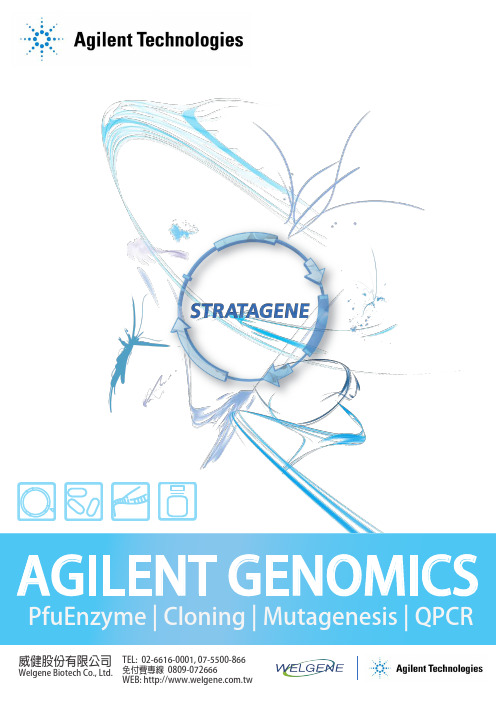
15
Real-Time PCR
16
Mx3000P QPCR System
17
Brilliant III Ultra-Fast SYBR Green QPCR and QRT-PCR Reagents
18
Brilliant III Ultra-Fast QPCR and QRT-PCR Reagents
Agilent / STRATAGENE
Agilent website: /genomics
Welgene | Agilent Stratagene
威健股份有限公司 | Stratagene 總代理
Table of Content
Table of Contents
/ XL1-Red Competent Cells SoloPack Gold Supercompetent Cells
/ TK Competent Cells Specialty Cells
/ Classic Cells / Fine Chemicals For Competent Cells
適用於 UNG 去汙染或 bisulphite
sequencing
適用於 TA Cloning
最高敏感性
取代傳統 Taq 的好選擇
-
2
威健股份有限公司 | Stratagene 總代理
PCR Enzyme & Instrument
Agilent SureCycler 8800
市場上領先的 cycling 速度和 sample 體積 10 ~ 100 μL 簡易快速可以選擇 96 well 和 384 well 操作盤 優秀的溫控設備讓各個 well 都能保持溫度的穩定 七吋的高解析度觸控螢幕讓操作上更為簡便 可以透過網路遠端操控儀器及監控儀器 Agilent 專業的技術支援可以幫助您應對各種 PCR 的問題
一种国产胃泌素释放肽前体化学发光免疫试剂的性能验证

一种国产胃泌素释放肽前体化学发光 免疫试剂的性能验证
欧赛英1,徐海伟1,陈秀发1,沙利烽1,梁 辰2,冯 杰2,薛 辉2,颜光涛2
(1.苏州长光华医生物试剂有限公司,江苏 苏州 215163; 2.中国人民解放军总医院医学检验中心,北京 100853)
ThePerformanceVerificationofaDomesticGastrinreleasing PeptideforChemiluminescenceImmunoreagent
OU Saiying1,XU Haiwei1,CHEN Xiufa1,SA Lifeng1,LIANG Chen2, FENG Jie2,XUEHui2,YAN Guangtao2
(1.SuzhouChangguanghuaMedicalReagentCo.LTD,Suzhou215163,China; 2.MedicalLaboratoryCenterofPLA GeneralHospital,Beijing100853,China)
Abstract:ObjectiveProGRPisapromisingeffectivetumormarkerindiscriminatingSCLCfrom NSCLCand otherbenignlungdiseases.ProGRPChemiluminescentimmunoassay(CLIA)wasdevelopedandmanufactured byHybiome.Themanufacturerdeclaredtheperformanceparametersasfollowing:theprecisionofthereagent waslessthan10%,thelimitofdetectionwas5pg/mL,therecoverywasbetween <±10%,thereference rangewas<65pg/mL,thelinearrangewas153000pg/mL,theserum waswellcorrelatedwithplasma,and theserum stabilitycouldreach96hours,andthecorrelationwithRocheelectrochemiluminescenceproGRP reagentwasgood.Theperformanceofthereagentwasverifiedinthisstudy.MethodsAccordingtotheCLSI andCAP,theprecision,limitofquantitation,recoveryrate,linearrange,referenceinterval,serum plasma consistency,serum stabilityandcomplementinterferenceofthedomesticproGRPassayanditssupporting instrument,AE180detectionsystem,wereverified.199casesamplesfrom healthycontrol,smallcelllung cancer,nonsmallcelllungcancerandbenignlungdiseasepatients,weredetectedinparallelwithRocheE601 system tocomparetheconsistencyoftheresultsbetweenthetwodetectionsystems.ResultsThenewProGRP
高效液相色谱法测定甲基泼尼松龙琥珀酸钠含量

高效液相色谱法测定甲基泼尼松龙琥珀酸钠含量乔晓芳【摘要】目的建立测定甲基泼尼松龙琥珀酸钠含量的高效液相色谱(HPLC)法.方法色谱柱采用Thermo C18柱(250 mm×4.0 mm,5μm),流动相为乙腈-3%冰醋酸(29:71),检测波长为254 nm,柱温为25℃,流速为1.0 mL/min,进样量为20μL.结果甲基泼尼松龙琥珀酸钠质量浓度在0.08~0.12 g/L范围内与峰面积线性关系良好(r=0.9995);平均回收率为99.16%,RSD为0.09%(n=5).结论该方法准确性高,重复性好,可用于甲基泼尼松龙琥珀酸钠原料药的质量控制.%Objective To establish an HPLC method for the content determination of methylprednisolone sodium succinate. Methods The mobile phase consisted of acetonitrile-3% glacial acetic acid(29 :71). The detection wavelength was 254 nm, the column temperature was 25 ℃ and the flow rate was 1. 0 mL/min. The sample volume was 20 μL. Results The linear relation of the concentration and peak area was good in the range of 0. 08-0. 12 mg/mL( r=0. 9995). The average percentage of recovery was 99. 16%, the RSD was 0. 09%( n=5). Conclusion The method is accurate and reproducible, which can be used for the quality control of methylprednisolone sodium succinate.【期刊名称】《中国药业》【年(卷),期】2017(026)005【总页数】3页(P29-31)【关键词】甲基泼尼松龙琥珀酸钠;高效液相色谱法;含量测定【作者】乔晓芳【作者单位】河南省食品药品审评查验中心,河南郑州 450000【正文语种】中文【中图分类】R927.2甲基泼尼松龙琥珀酸钠是甲基泼尼松龙琥珀酸钠针的原料药,临床上主要用于抗炎[1-2]、免疫抑制、休克[3-5]和内分泌失调的治疗。
一种外周循环血lncRNA用于诊断早期原发性肝癌、制备原发性肝癌筛查
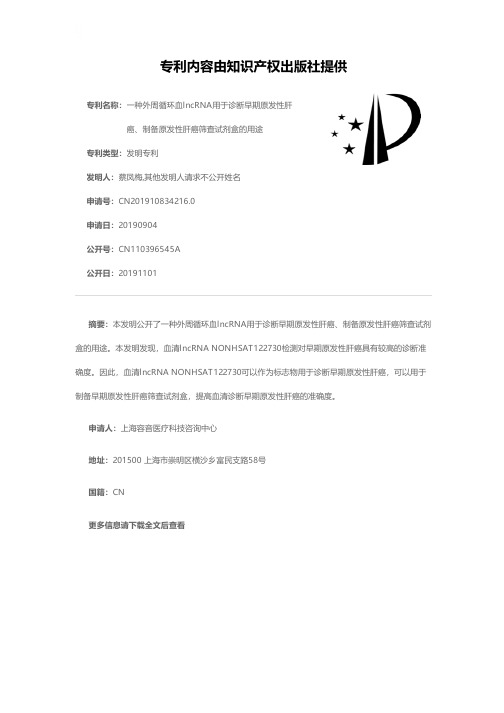
专利名称:一种外周循环血lncRNA用于诊断早期原发性肝癌、制备原发性肝癌筛查试剂盒的用途
专利类型:发明专利
发明人:蔡凤梅,其他发明人请求不公开姓名
申请号:CN201910834216.0
申请日:20190904
公开号:CN110396545A
公开日:
20191101
专利内容由知识产权出版社提供
摘要:本发明公开了一种外周循环血lncRNA用于诊断早期原发性肝癌、制备原发性肝癌筛查试剂盒的用途。
本发明发现,血清lncRNA NONHSAT122730检测对早期原发性肝癌具有较高的诊断准确度。
因此,血清lncRNA NONHSAT122730可以作为标志物用于诊断早期原发性肝癌,可以用于制备早期原发性肝癌筛查试剂盒,提高血清诊断早期原发性肝癌的准确度。
申请人:上海容音医疗科技咨询中心
地址:201500 上海市崇明区横沙乡富民支路58号
国籍:CN
更多信息请下载全文后查看。
一种医药用避光材料中颜料红254迁移溶出的微量测定方法
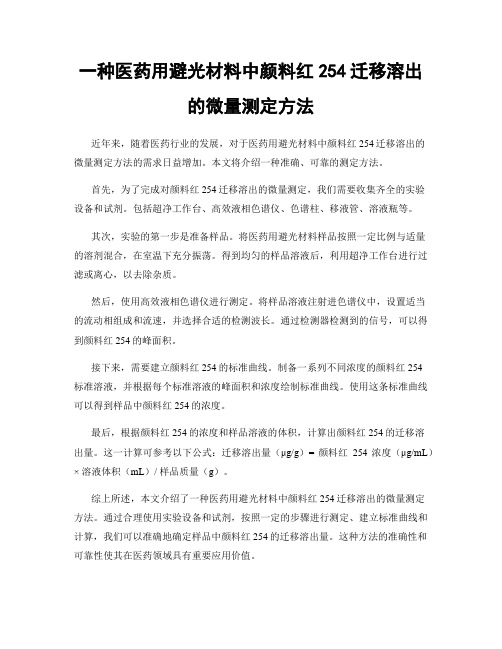
一种医药用避光材料中颜料红254迁移溶出
的微量测定方法
近年来,随着医药行业的发展,对于医药用避光材料中颜料红254迁移溶出的
微量测定方法的需求日益增加。
本文将介绍一种准确、可靠的测定方法。
首先,为了完成对颜料红254迁移溶出的微量测定,我们需要收集齐全的实验
设备和试剂。
包括超净工作台、高效液相色谱仪、色谱柱、移液管、溶液瓶等。
其次,实验的第一步是准备样品。
将医药用避光材料样品按照一定比例与适量
的溶剂混合,在室温下充分振荡。
得到均匀的样品溶液后,利用超净工作台进行过滤或离心,以去除杂质。
然后,使用高效液相色谱仪进行测定。
将样品溶液注射进色谱仪中,设置适当
的流动相组成和流速,并选择合适的检测波长。
通过检测器检测到的信号,可以得到颜料红254的峰面积。
接下来,需要建立颜料红254的标准曲线。
制备一系列不同浓度的颜料红254
标准溶液,并根据每个标准溶液的峰面积和浓度绘制标准曲线。
使用这条标准曲线可以得到样品中颜料红254的浓度。
最后,根据颜料红254的浓度和样品溶液的体积,计算出颜料红254的迁移溶
出量。
这一计算可参考以下公式:迁移溶出量(μg/g)= 颜料红254浓度(μg/mL)×溶液体积(mL)/ 样品质量(g)。
综上所述,本文介绍了一种医药用避光材料中颜料红254迁移溶出的微量测定
方法。
通过合理使用实验设备和试剂,按照一定的步骤进行测定、建立标准曲线和计算,我们可以准确地确定样品中颜料红254的迁移溶出量。
这种方法的准确性和可靠性使其在医药领域具有重要应用价值。
【CN109674749A】一种高含量辅酶Q10口服纳米混悬剂及其制备工艺【专利】
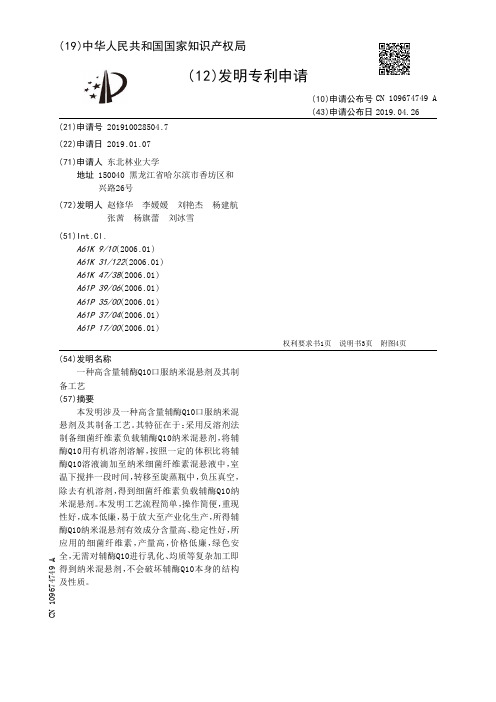
2
CN 109674749 A
说 明 书
1/3 页
一种高含量辅酶Q10口服纳米混悬剂及其制备工艺
技术领域 [0001] 本发明涉及一种高含量辅酶Q10口服纳米混悬剂及其制备工艺,特别涉及一种具 有操作工艺简单、易于扩大、易产业化,辅酶Q10含量高、稳定性好等优点的高含量辅酶Q10 口服纳米混悬剂及其制备工艺。
( 54 )发明 名称 一种高含量辅酶Q10口服纳米混悬剂及其制
备工艺 ( 57 )摘要
本发明涉及一种高含量辅酶Q10口服纳米混 悬剂及其 制备工艺。其特征在于 :采 用反溶剂法 制备 细菌纤维素 负载辅酶Q10纳米混悬剂 ,将辅 酶Q10 用有机溶剂溶解 ,按照一定的 体积比 将辅 酶Q10溶液滴加至纳米细菌纤维素混悬液中 ,室 温下搅拌一段时间 ,转移至旋蒸瓶中 ,负压真空 , 除 去有机溶剂 ,得到细菌纤维素 负载辅酶Q10纳 米混悬剂。本发明工艺流程简单,操作简便,重现 性好,成本低廉,易于放大至产业化生产,所得辅 酶Q10纳米混悬剂有效成分含量高、稳定性好,所 应用的细菌纤维素 ,产量高 ,价格低廉 ,绿色安 全,无需对辅酶Q10进行乳化、均质等复杂加工即 得到纳米混悬剂 ,不会破坏辅酶Q10本身的 结构 及性质。
(10)申请公布号 CN 109674749 A (43)申请公布日 2019.04.26
权利要求书1页 说明书3页 附图4页
CN 109674749 A
CN 109674749 A
权 利 要 求 书
1ห้องสมุดไป่ตู้1 页
1 .一种高含量辅酶Q10口服纳米混悬剂及其制备工艺,包括以下步骤:首先利用产细菌 纤维素菌属静态培养得到细菌纤维素湿膜,湿膜用去离子水清洗,氢氧化钠溶液加热去除 剩余的 介 质和细胞 ,对BC膜进行反复洗涤 ,直至pH为中性 ,然后将细菌纤维素湿膜干燥 ,粉 碎 ,得到细菌纤维素粉末。将细菌纤维粉末与35%~65%的 稀硫酸溶液按照一定的 质量比 混合 ,置于35~65℃恒温水浴锅中搅拌至细菌纤维素呈均匀的 浆 糊状 ,然后 用去离子水稀 释混合物 ,继续加入混合物体积2%~10%的过氧化氢,室温下搅拌0 .5h。最后,将混合物离 心 ,沉淀 用去离子水超声分散后 ,转移至透析袋中 ,1~2天换一次水 ,直至透析袋内外溶液 为中性,透析袋内混悬液即为纳米细菌纤维素混悬液,置于4℃保存,备用。采用反溶剂法制 备细菌纤维素负载辅酶Q10纳米混悬剂,将辅酶Q10用有机溶剂溶解,得到一定浓度的辅酶 Q10溶液 ,将纳米细菌纤维素混悬液稀释成一定浓度 ,按照一定的 体积比 将辅酶Q10溶液滴 加至纳米细菌纤维素混悬液中 ,室温下搅拌一段时间 ,负压真空 ,除 去有机溶剂 ,所得混合 物即细菌纤维素负载辅酶Q10纳米混悬剂。
高效分子排阻法测定注射用氨曲南中聚合物的含量
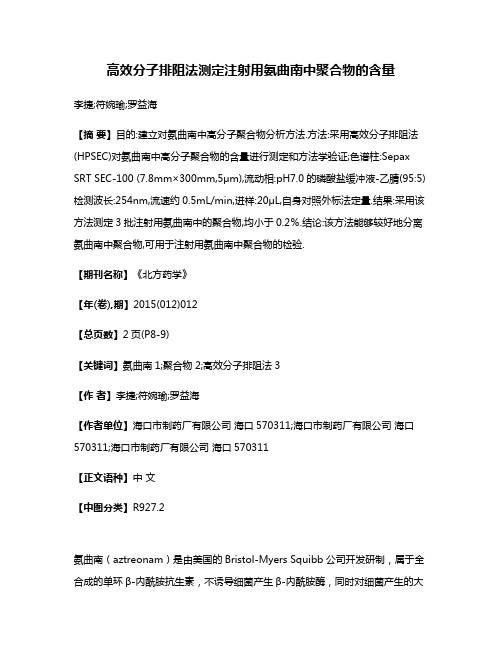
高效分子排阻法测定注射用氨曲南中聚合物的含量李捷;符婉瑜;罗益海【摘要】目的:建立对氨曲南中高分子聚合物分析方法.方法:采用高效分子排阻法(HPSEC)对氨曲南中高分子聚合物的含量进行测定和方法学验证;色谱柱:Sepax SRT SEC-100 (7.8mm×300mm,5μm),流动相:pH7.0的磷酸盐缓冲液-乙腈(95:5)检测波长:254nm,流速约0.5mL/min,进样:20μL,自身对照外标法定量.结果:采用该方法测定3批注射用氨曲南中的聚合物,均小于0.2%.结论:该方法能够较好地分离氨曲南中聚合物,可用于注射用氨曲南中聚合物的检验.【期刊名称】《北方药学》【年(卷),期】2015(012)012【总页数】2页(P8-9)【关键词】氨曲南1;聚合物2;高效分子排阻法3【作者】李捷;符婉瑜;罗益海【作者单位】海口市制药厂有限公司海口570311;海口市制药厂有限公司海口570311;海口市制药厂有限公司海口570311【正文语种】中文【中图分类】R927.2氨曲南(aztreonam)是由美国的Bristol-Myers Squibb公司开发研制,属于全合成的单环β-内酰胺抗生素,不诱导细菌产生β-内酰胺酶,同时对细菌产生的大多数β-内酰胺酶高度稳定。
此类药物最常见的不良反应就是过敏反应。
多年来的研究已经证明,在β-内酰胺类抗生素所致的速发型过敏反应中,药物分子本身只是半抗原,药物中存在的高分子有关物质Ⅱ才是引发速发型过敏反应的过敏原,因此严格控制抗生素中高分子聚合物的含量有着重要的意义。
本文建立高效分子排阻法(HPSEC)对氨曲南中高分子聚合物的含量测定情况,所建立方法专属性强、简便、快速、结果准确,有效控制产品质量。
1 试验材料1.1 仪器:Waters515输液泵(美国Waters公司)Waters2487紫外检测器(美国Waters公司)YH-3000色谱工作站,CP225D十万分之一天平。
高效液相色谱法测定替格瑞洛原料药中异构体的含量
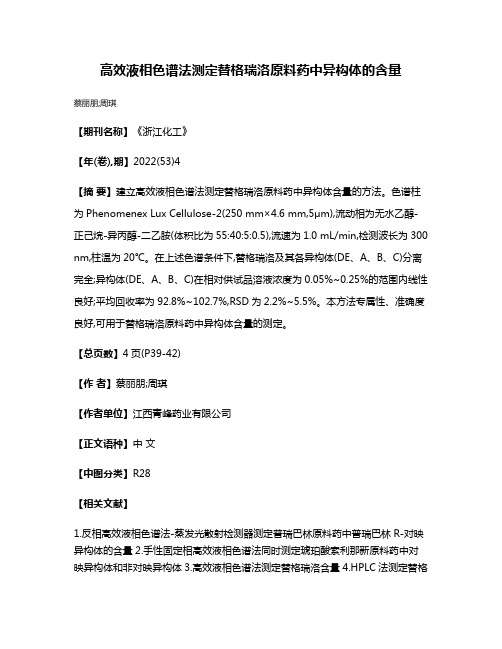
高效液相色谱法测定替格瑞洛原料药中异构体的含量
蔡丽朋;周琪
【期刊名称】《浙江化工》
【年(卷),期】2022(53)4
【摘要】建立高效液相色谱法测定替格瑞洛原料药中异构体含量的方法。
色谱柱为Phenomenex Lux Cellulose-2(250 mm×4.6 mm,5μm),流动相为无水乙醇-正己烷-异丙醇-二乙胺(体积比为55:40:5:0.5),流速为1.0 mL/min,检测波长为300 nm,柱温为20℃。
在上述色谱条件下,替格瑞洛及其各异构体(DE、A、B、C)分离完全;异构体(DE、A、B、C)在相对供试品溶液浓度为0.05%~0.25%的范围内线性良好;平均回收率为92.8%~102.7%,RSD为2.2%~5.5%。
本方法专属性、准确度良好,可用于替格瑞洛原料药中异构体含量的测定。
【总页数】4页(P39-42)
【作者】蔡丽朋;周琪
【作者单位】江西青峰药业有限公司
【正文语种】中文
【中图分类】R28
【相关文献】
1.反相高效液相色谱法-蒸发光散射检测器测定普瑞巴林原料药中普瑞巴林R-对映异构体的含量
2.手性固定相高效液相色谱法同时测定琥珀酸索利那新原料药中对映异构体和非对映异构体
3.高效液相色谱法测定替格瑞洛含量
4.HPLC法测定替格
瑞洛原料药和替格瑞洛片的含量5.高效液相色谱法测定替格瑞洛原料药中基因毒性杂质的含量
因版权原因,仅展示原文概要,查看原文内容请购买。
愈美分散片的HPLC测定
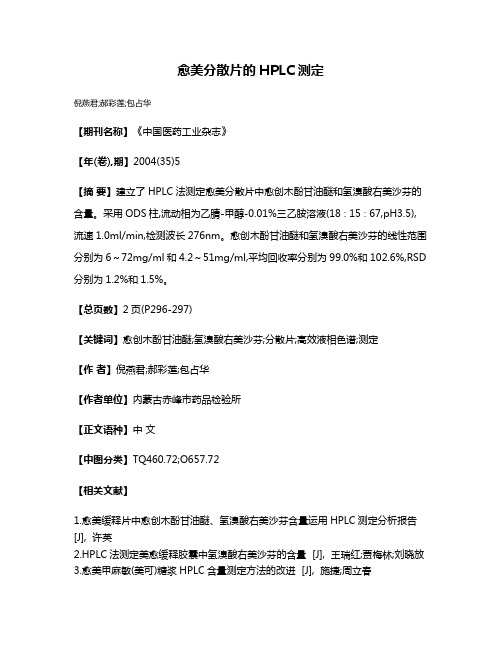
愈美分散片的HPLC测定
倪燕君;郝彩莲;包占华
【期刊名称】《中国医药工业杂志》
【年(卷),期】2004(35)5
【摘要】建立了HPLC法测定愈美分散片中愈创木酚甘油醚和氢溴酸右美沙芬的含量。
采用ODS柱,流动相为乙腈-甲醇-0.01%三乙胺溶液(18∶15∶67,pH3.5), 流速1.0ml/min,检测波长276nm。
愈创木酚甘油醚和氢溴酸右美沙芬的线性范围分别为6~72mg/ml和4.2~51mg/ml,平均回收率分别为99.0%和102.6%,RSD 分别为1.2%和1.5%。
【总页数】2页(P296-297)
【关键词】愈创木酚甘油醚;氢溴酸右美沙芬;分散片;高效液相色谱;测定
【作者】倪燕君;郝彩莲;包占华
【作者单位】内蒙古赤峰市药品检验所
【正文语种】中文
【中图分类】TQ460.72;O657.72
【相关文献】
1.愈美缓释片中愈创木酚甘油醚、氢溴酸右美沙芬含量运用HPLC测定分析报告[J], 许英
2.HPLC法测定美愈缓释胶囊中氢溴酸右美沙芬的含量 [J], 王瑞红;贾梅林;刘晓放
3.愈美甲麻敏(美可)糖浆HPLC含量测定方法的改进 [J], 施捷;周立春
因版权原因,仅展示原文概要,查看原文内容请购买。
